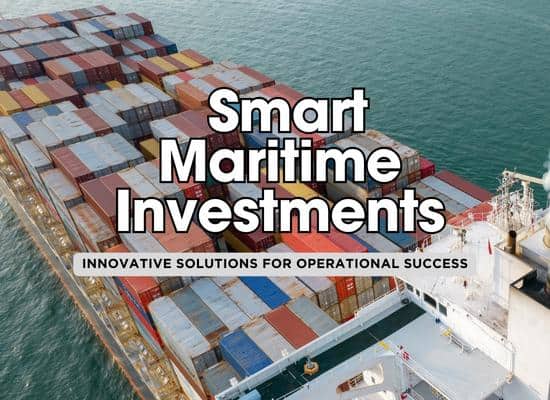15 of the Smartest Investments for Shipowners in 2025

Navigating the complexities of the maritime industry requires shipowners to stay ahead with strategic investments that balance operational efficiency, regulatory compliance, and sustainability. While the possibilities are vast, this guide highlights 15 impactful investments that should be on every shipowner’s radar in 2025. These selections represent a curated list of advancements and practices poised to deliver impressive ROI and future-proof fleets against evolving challenges.

** Did we miss an investment that should have been included? Please send suggestions by email to editor at shipuniverse.com **
1️⃣ Dual-Fuel Engines for Flexible Fuel Options ⛽
Overview
Dual-fuel engines can run on both traditional marine fuels (e.g., heavy fuel oil) and alternative fuels like LNG or methanol. This flexibility helps shipowners adapt to volatile fuel prices and meet stringent environmental standards.
Cost
- New Installations: The initial cost for dual-fuel engines is higher than traditional engines due to advanced technology, ranging from $10–$15 million per vessel for large installations.
- Retrofits: Retrofitting existing vessels can cost $1–$3 million, but feasibility depends on the ship’s design and age.
ROI
- Fuel savings from using cheaper or lower-emission fuels like LNG.
- Long-term regulatory compliance reduces penalties or restrictions.
- Payback period: 5–10 years, depending on operational routes and fuel price trends.
Why it makes sense
- Regulatory Compliance: Meets IMO’s decarbonization targets for 2030 and beyond.
- Fuel Flexibility: Adaptable to future low-carbon fuels like ammonia.
- Future-Proofing: Reduces risks of stranded assets as the industry transitions to greener fuels.
2️⃣ Advanced Ballast Water Treatment Systems (BWTS) 🌊
Overview
BWTS are mandatory for vessels to neutralize invasive species in ballast water, ensuring compliance with international environmental regulations like the IMO Ballast Water Management Convention.
Cost
- Installation: Ranges from $500,000 to $5 million, depending on the system type (UV, chemical, or filtration) and vessel size.
- Operational Costs: Maintenance and energy consumption vary, but UV-based systems are considered cost-effective for long-term use.
ROI
- Avoids non-compliance fines that can exceed $25,000 per violation.
- Uninterrupted access to global ports ensures smooth operations.
- Payback period: 3–6 years, depending on trading routes and system efficiency.
Why it makes sense
- Compliance: Mandatory for global operations; avoiding fines and detentions.
- Environmental Responsibility: Helps protect marine ecosystems.
- Operational Access: Ensures eligibility to dock at environmentally strict ports.
3️⃣ Real-Time Fuel Monitoring Systems 📊
Overview
Fuel monitoring systems provide live data on fuel consumption, enabling optimized engine performance, reduced costs, and compliance with emission regulations.
Cost
- Installation: Moderate cost, around $20,000 to $50,000 per vessel, depending on existing systems and vessel size.
- Operational Costs: Minimal, limited to periodic maintenance and data management.
ROI
- Potential fuel savings of 5–10% annually. For a large cargo ship consuming $3 million worth of fuel annually, this translates to $150,000–$300,000 in savings per year.
- Payback period: 1–3 years, depending on fuel prices and vessel operations.
Why it makes sense
- Cost Savings: Immediate reduction in fuel expenses.
- Regulatory Compliance: Helps achieve emission reduction targets.
- Enhanced Efficiency: Provides actionable insights for better decision-making.
4️⃣ Onboard Renewable Energy Solutions (e.g., Wind-Assisted Propulsion) 🌬️
Overview
Integrating renewable energy sources, such as wind-assisted propulsion systems, into vessels can significantly reduce fuel consumption and greenhouse gas emissions. Technologies like Flettner rotors, wingsails, and kite sails harness wind energy to assist in propelling ships, leading to more sustainable operations.
Cost
- Installation: The cost varies depending on the technology and vessel size. For instance, retrofitting a vessel with Flettner rotors can range from $1 million to $2 million per rotor.
- Operational Costs: These systems generally have low operational costs, primarily involving maintenance and occasional inspections.
ROI
- Fuel Savings: Wind-assisted propulsion can lead to fuel savings of up to 10–20%, depending on the route and wind conditions.
- Payback Period: The investment can be recouped within 5–10 years, influenced by fuel prices and operational patterns.
Why it makes sense
- Environmental Compliance: Assists in meeting IMO’s emission reduction targets.
- Cost Efficiency: Reduces reliance on fossil fuels, leading to significant cost savings over time.
- Sustainability: Demonstrates a commitment to green shipping practices, enhancing corporate reputation.
5️⃣ Upgraded Reefer Containers with Smart Tracking 📦
Overview
Modernizing refrigerated (reefer) containers with smart tracking technology allows for real-time monitoring of temperature, humidity, and location. This ensures the integrity of perishable goods throughout the supply chain.
Cost
- Upgrade Cost: Equipping a reefer container with smart tracking devices costs approximately $500 to $1,000 per unit.
- Operational Costs: Minimal, mainly related to data management and connectivity.
ROI
- Reduced Cargo Loss: Real-time monitoring helps prevent spoilage, reducing insurance claims and cargo losses.
- Operational Efficiency: Enhanced visibility leads to better asset utilization and logistics planning.
- Payback Period: Investments can be recovered within 2–3 years through cost savings and improved service quality.
Why it makes sense
- Quality Assurance: Maintains optimal conditions for temperature-sensitive cargo, ensuring customer satisfaction.
- Competitive Advantage: Offers value-added services to clients, differentiating from competitors.
- Regulatory Compliance: Meets increasing regulatory demands for traceability in the food and pharmaceutical industries.
6️⃣ IoT-Enabled Fleet Management Platforms 📡
Overview
Implementing Internet of Things (IoT) technology in fleet management enables real-time data collection on vessel performance, location, and environmental conditions. This facilitates informed decision-making and predictive maintenance.
Cost
- Implementation: The cost for IoT integration varies based on fleet size and system complexity, typically ranging from $100,000 to $500,000.
- Operational Costs: Ongoing expenses include data storage, analysis, and system maintenance.
ROI
- Maintenance Savings: Predictive maintenance reduces unplanned downtime and repair costs.
- Fuel Efficiency: Optimized operations can lead to fuel savings of 5–10%.
- Payback Period: Approximately 3–5 years, depending on fleet operations and efficiency gains.
Why it makes sense
- Operational Efficiency: Enhances route planning, fuel management, and overall fleet performance.
- Safety: Real-time monitoring improves response times to potential issues, enhancing crew and vessel safety.
- Data-Driven Decisions: Provides actionable insights, leading to informed strategic planning.
7️⃣ Autonomous Navigation Systems 🛳️
Overview
Autonomous navigation systems utilize advanced technologies such as artificial intelligence (AI), sensors, and machine learning to enable vessels to operate with reduced human intervention. These systems enhance operational efficiency, safety, and can significantly reduce operational costs.
Cost
- Implementation: Retrofitting a medium-sized cargo ship with autonomous technology can cost between $7–$10 million, depending on the level of autonomy and the existing condition of the ship.
- Operational Costs: While autonomous systems can reduce crew-related expenses, they may incur additional costs related to maintenance, software updates, and remote monitoring infrastructure.
ROI
- Cost Savings: Automation could cut labor costs by up to 90%, as autonomous ships reduce the need for large onboard crews.
- Efficiency Gains: AI-based navigation platforms can optimize routing and scheduling, leading to fuel savings and reduced transit times.
- Payback Period: The payback period varies based on operational savings and initial investment but is generally projected within 5–10 years.
Why it makes sense
- Enhanced Safety: Autonomous systems can monitor and predict potential hazards, reducing the risk of human error and improving overall safety.
- Regulatory Compliance: AI can assist in adhering to environmental regulations by optimizing operations to reduce emissions.
- Future-Proofing: Investing in autonomous technology positions shipowners at the forefront of maritime innovation, ensuring competitiveness in a rapidly evolving industry.
8️⃣ Carbon Capture Systems for Compliance and Sustainability ♻️
Overview
Onboard carbon capture systems are designed to extract CO₂ emissions directly from a ship’s exhaust, storing the captured carbon for later offloading and sequestration. This technology enables vessels to meet stringent environmental regulations without solely relying on alternative fuels.
Cost
- Installation: The cost of installing a carbon capture system capable of capturing 90% of CO₂ emissions is estimated at around $30 million per vessel.
- Operational Costs: Annual operating expenses for such systems are estimated to exceed $2 million, adding approximately 25% to a ship’s annual operating costs.
ROI
- Regulatory Compliance: Avoidance of potential fines and restrictions associated with non-compliance to emission standards.
- Market Access: Maintaining access to markets with strict environmental regulations, ensuring continued revenue streams.
- Payback Period: Given the high installation and operational costs, the payback period is longer and depends on factors such as carbon credit pricing and fuel costs.
Why it makes sense
- Environmental Impact: Significantly reduces greenhouse gas emissions, contributing to global climate goals.
- Regulatory Alignment: Positions shipowners to comply with current and future environmental regulations, mitigating the risk of non-compliance penalties.
- Sustainability Leadership: Demonstrates a commitment to sustainable practices, enhancing corporate reputation and stakeholder relations.
9️⃣ AI-Driven Predictive Maintenance Tools 🛠️
Overview
AI-driven predictive maintenance tools analyze data from various ship systems to predict potential equipment failures before they occur. This proactive approach minimizes downtime, reduces maintenance costs, and extends the lifespan of vessel components.
Cost
- Implementation: The cost varies based on the complexity of the system and the size of the fleet but is generally considered a moderate investment relative to the potential savings.
- Operational Costs: Ongoing expenses include data processing, software licensing, and occasional hardware maintenance.
ROI
- Cost Savings: By preventing unexpected equipment failures, operators can save significantly on emergency repairs and associated downtime.
- Efficiency Gains: Optimized maintenance schedules improve vessel availability and operational efficiency.
- Payback Period: Typically 1–3 years, depending on the scale of operations and the effectiveness of the predictive maintenance system.
Why it makes sense
- Operational Reliability: Enhances the reliability of vessel operations by reducing the likelihood of unexpected breakdowns.
- Cost Efficiency: Optimizes maintenance budgets by focusing resources on components that genuinely need attention.
- Data-Driven Decisions: Empowers shipowners with actionable insights, facilitating informed decision-making and strategic planning.
🔟 Crew Welfare Enhancements (e.g., High-Speed Internet) 📶
Overview
Enhancing crew welfare by providing amenities such as high-speed internet, comfortable living quarters, and mental health support is crucial for maintaining a motivated and efficient workforce. Investing in crew welfare not only improves the quality of life for seafarers but also leads to increased productivity and reduced turnover rates.
Cost
- High-Speed Internet Installation: Implementing reliable internet connectivity on ships can involve an initial setup cost ranging from $10,000 to $50,000, depending on the vessel's size and existing infrastructure.
- Ongoing Expenses: Monthly operational costs for internet services can range from $1,000 to $5,000, influenced by bandwidth requirements and service providers.
ROI
- Reduced Turnover: Improved welfare leads to higher crew retention, saving costs associated with recruiting and training new personnel.
- Enhanced Productivity: A satisfied crew is more efficient, leading to smoother operations and fewer disruptions.
- Payback Period: Investments in crew welfare can yield returns within 1–2 years, considering savings from reduced turnover and enhanced operational efficiency.
Why it makes sense
- Regulatory Compliance: Aligns with international labor standards, such as the Maritime Labour Convention (MLC) 2006, ensuring fair treatment of seafarers.
- Competitive Advantage: Attracts and retains skilled crew members, giving shipowners an edge in a competitive market.
- Operational Safety: Content and well-supported crew contribute to safer ship operations, reducing the risk of accidents.
1️⃣1️⃣ 3D Printing Technology for Onboard Repairs 🖨️
Overview
Integrating 3D printing technology onboard allows ships to manufacture spare parts and tools on-demand, reducing dependency on shore-based suppliers and minimizing downtime due to equipment failures.
Cost
- 3D Printer Acquisition: The cost of industrial-grade 3D printers suitable for maritime use ranges from $50,000 to $500,000, depending on capabilities and materials used.
- Materials and Maintenance: Ongoing expenses include raw materials (e.g., metal powders or filaments) and maintenance, estimated at $10,000 to $50,000 annually.
ROI
- Inventory Reduction: Decreases the need to stockpile spare parts, freeing up storage space and reducing capital tied up in inventory.
- Minimized Downtime: Enables quick production of critical components, reducing delays caused by waiting for parts delivery.
- Payback Period: Approximately 2–4 years, depending on the frequency of part replacements and associated costs.
Why it makes sense
- Operational Resilience: Enhances the vessel's ability to address mechanical issues independently, ensuring continuous operations.
- Cost Savings: Lowers expenses related to expedited shipping of parts and potential demurrage charges due to delays.
- Innovation Leadership: Positions shipowners at the forefront of technological adoption, showcasing a commitment to efficiency and modernization.
1️⃣2️⃣ Investments in Maritime Cybersecurity 🔒
Overview
As ships become increasingly connected through digital systems, the risk of cyber threats escalates. Investing in robust cybersecurity measures protects critical navigation and operational systems from potential attacks.
Cost
- Cybersecurity Solutions: Implementing comprehensive cybersecurity measures, including software, hardware, and training, can cost between $100,000 to $500,000 per vessel, depending on the complexity of the systems.
- Ongoing Maintenance: Regular updates, monitoring, and incident response services may add $50,000 to $100,000 annually.
ROI
- Risk Mitigation: Prevents potential financial losses from cyber incidents, which can average $3.86 million per breach across industries.
- Regulatory Compliance: Adheres to guidelines set by organizations like the International Maritime Organization (IMO), avoiding penalties.
- Payback Period: Difficult to quantify precisely, but the investment is justified by the high cost of potential cyber incidents.
Why it makes sense
- Operational Integrity: Ensures the reliability and safety of critical ship systems, preventing disruptions.
- Reputation Management: Protects the company's reputation by safeguarding against high-profile security breaches.
- Future Preparedness: Establishes a proactive stance against evolving cyber threats, maintaining stakeholder confidence.
1️⃣3️⃣ Green Financing for New Build Eco-Ships 🌱
Overview
Green financing involves securing funds specifically allocated for environmentally sustainable projects, such as constructing eco-friendly vessels. Financial institutions offer favorable terms to shipowners investing in ships that meet stringent environmental standards, aligning with global decarbonization goals.
Cost
- Interest Rates: Green loans often come with reduced interest rates compared to traditional financing, incentivizing sustainable investments.
- Compliance Costs: While initial construction costs may be higher due to advanced green technologies, these are offset by the benefits of green financing and long-term operational savings.
ROI
- Operational Savings: Eco-ships typically consume less fuel and incur lower emission-related charges, leading to significant cost reductions over time.
- Market Advantage: Possessing a green fleet can attract environmentally conscious clients, opening new market opportunities.
- Payback Period: The payback period varies but is generally favorable due to operational savings and potential incentives.
Why it makes sense
- Regulatory Compliance: Aligns with international environmental regulations, reducing the risk of future non-compliance costs.
- Access to Capital: Facilitates easier access to capital, as many financial institutions prioritize funding sustainable projects.
- Reputational Benefits: Enhances corporate image by demonstrating a commitment to sustainability.
1️⃣4️⃣ Sustainable Ship Recycling Practices 🔄
Overview
Implementing sustainable ship recycling practices ensures that vessels are dismantled in an environmentally responsible manner at the end of their operational life. This approach minimizes environmental harm and adheres to international regulations, such as the Hong Kong International Convention for the Safe and Environmentally Sound Recycling of Ships.
Cost
- Recycling Expenses: Environmentally sound recycling may incur higher costs compared to traditional methods due to stricter safety and environmental standards.
- Certification Costs: Obtaining certifications for green recycling practices involves additional expenses.
ROI
- Material Recovery: Recycling allows for the recovery and sale of valuable materials, offsetting some costs.
- Regulatory Compliance: Avoids potential fines and sanctions associated with non-compliant recycling methods.
- Payback Period: While direct financial returns may be modest, the broader benefits contribute to a positive ROI over time.
Why it makes sense
- Environmental Responsibility: Demonstrates a commitment to reducing environmental impact.
- Regulatory Alignment: Ensures compliance with current and future regulations, mitigating legal risks.
- Stakeholder Trust: Builds trust with stakeholders who value corporate social responsibility.
1️⃣5️⃣ Alternative Fuel Infrastructure Development 🛢️
Overview
Investing in infrastructure to support alternative fuels, such as LNG, hydrogen, or ammonia, is crucial for the transition to low-carbon shipping. Developing bunkering facilities and supply chains for these fuels enables the adoption of cleaner energy sources.
Cost
- Infrastructure Investment: Establishing alternative fuel infrastructure requires substantial capital expenditure, influenced by the type of fuel and regional factors.
- Maintenance Costs: Ongoing maintenance and operational costs are associated with managing new fuel types.
ROI
- Future-Proofing: Positions shipowners to meet future regulatory requirements and market demands for low-emission shipping.
- Competitive Edge: Early investment provides a competitive advantage as the industry shifts towards alternative fuels.
- Payback Period: Long-term, depending on fuel adoption rates and regulatory developments.
Why it makes sense
- Regulatory Compliance: Proactively addresses impending environmental regulations.
- Market Positioning: Aligns with global trends towards sustainability, attracting eco-conscious clients.
- Operational Resilience: Diversifies fuel options, reducing dependency on traditional fuels and associated market volatility.
Investing in these strategic areas not only ensures compliance with evolving environmental regulations but also enhances operational efficiency and market competitiveness. By adopting sustainable practices and technologies, shipowners can secure a prosperous future in the maritime industry, balancing economic performance with environmental stewardship.
Table Summary
| ShipUniverse: Top 15 Smartest Investments for Shipowners in 2025 | |||
|---|---|---|---|
| Investment | Cost | ROI | Why It's Worth It |
| Dual-Fuel Engines for Flexible Fuel Options | $10M–$15M per vessel for new installations; $1M–$3M for retrofits. Operational costs depend on fuel type. | 5–10 years depending on fuel price differentials and trading routes. | Enables compliance with IMO regulations, flexibility to switch between fuel types, and adapts to future fuels like ammonia. |
| Advanced Ballast Water Treatment Systems | $500K–$5M for installation. Operational costs depend on system type (UV, filtration, etc.). | 3–6 years, driven by savings from avoiding fines and ensuring global port access. | Mandatory for international operations, protects marine ecosystems, and ensures port eligibility worldwide. |
| Real-Time Fuel Monitoring Systems | $20K–$50K for installation; minimal operational costs for maintenance and data management. | 1–3 years based on fuel savings (5–10%) for large vessels. | Reduces fuel consumption, meets emission targets, and improves overall operational efficiency. |
| Onboard Renewable Energy Solutions | $1M–$2M per rotor for wind-assisted technologies; low operational costs. | 5–10 years depending on fuel price trends and wind conditions. | Cuts fuel consumption by up to 20%, meets decarbonization targets, and demonstrates sustainability leadership. |
| Upgraded Reefer Containers with Smart Tracking | $500–$1,000 per container for upgrades; minimal ongoing costs for connectivity and monitoring. | 2–3 years, with savings from reduced cargo losses and optimized logistics. | Ensures cargo quality, improves supply chain transparency, and provides a competitive edge in perishable goods markets. |
| IoT-Enabled Fleet Management Platforms | $100K–$500K for system implementation, with ongoing costs for data storage and analytics. | 3–5 years, driven by savings in fuel efficiency and optimized maintenance scheduling. | Enhances operational efficiency, improves safety, and facilitates data-driven decision-making. |
| Autonomous Navigation Systems | $7M–$10M for retrofitting medium-sized vessels; additional costs for remote monitoring. | 5–10 years, depending on savings from reduced crew costs and optimized routing. | Improves safety, reduces human error, and positions fleets for future regulatory and operational advancements. |
| Carbon Capture Systems | $30M for installation per vessel; $2M annually for operations and maintenance. | Long-term ROI, influenced by carbon credit markets and regulatory incentives. | Reduces CO₂ emissions, aligns with IMO decarbonization goals, and enhances environmental responsibility. |
| Crew Welfare Enhancements | $10K–$50K for high-speed internet installation; $1K–$5K monthly for connectivity. | 1–2 years, through reduced turnover and increased productivity. | Improves crew satisfaction and retention, meets MLC standards, and enhances operational safety. |
| 3D Printing Technology for Onboard Repairs | $50K–$500K for industrial-grade printers; $10K–$50K annually for materials and maintenance. | 2–4 years, with savings from reduced downtime and expedited part replacement. | Enhances self-sufficiency, minimizes delays, and reduces inventory and logistics costs. |
| Investments in Maritime Cybersecurity | $100K–$500K per vessel for robust cybersecurity solutions; $50K–$100K annually for maintenance. | Immediate ROI by preventing potential breaches, which can cost $3M–$5M per incident. | Safeguards critical systems, protects against financial losses, and ensures compliance with cybersecurity regulations. |
| Green Financing for New Build Eco-Ships | Favorable financing terms reduce interest rates compared to traditional loans; overall cost varies by vessel size and specifications. | Varies based on operational savings and incentives, typically long-term returns. | Promotes sustainable practices, secures regulatory compliance, and offers long-term operational cost savings. |
| Sustainable Ship Recycling Practices | Higher initial costs for eco-friendly recycling methods, varying by vessel size and location. | Indirect ROI through material recovery, compliance, and stakeholder trust. | Ensures environmental responsibility, aligns with regulations, and enhances corporate reputation. |
| Alternative Fuel Infrastructure Development | $5M–$50M depending on fuel type and scale; includes bunkering facilities and supply chains. | Long-term ROI tied to fuel adoption rates and operational savings. | Positions fleets for the future of low-carbon shipping, ensuring compliance and operational resilience. |
| Advanced Energy Storage Systems | $500K–$5M depending on vessel size and battery type (e.g., lithium-ion, hybrid systems). | 5–7 years, driven by fuel savings and reduced reliance on auxiliary engines. | Supports hybrid propulsion systems, cuts emissions, and ensures energy availability during low-load operations. |

Do you have a Maritime Product or Service that may be of interest to Shipowners? Tell us about it here!
Do you have feedback or insights? Please reach out to editor @ shipuniverse.com



